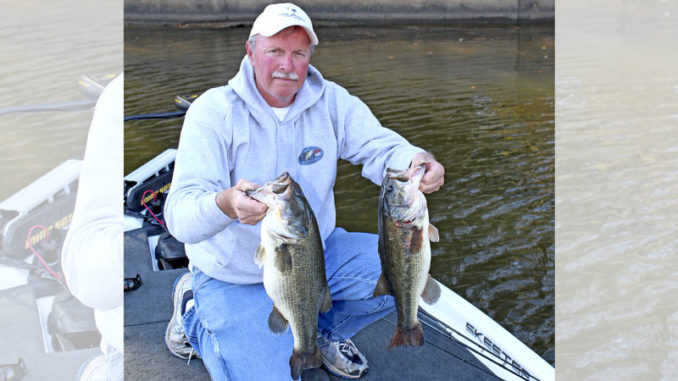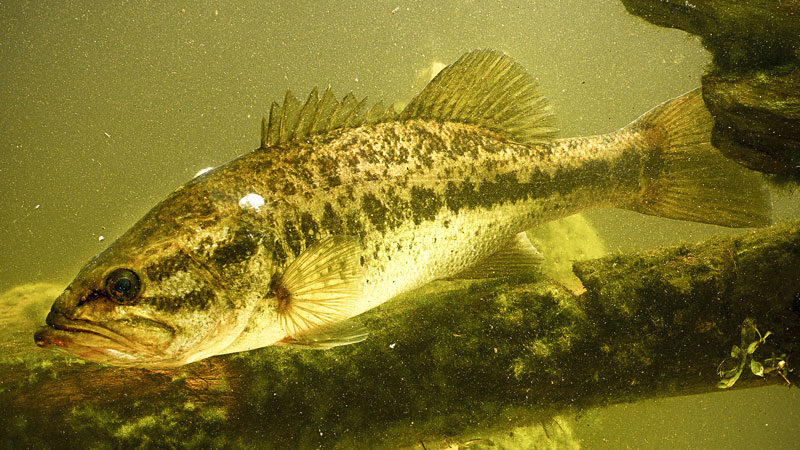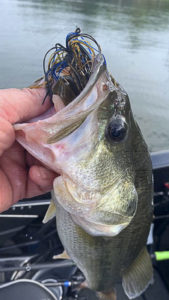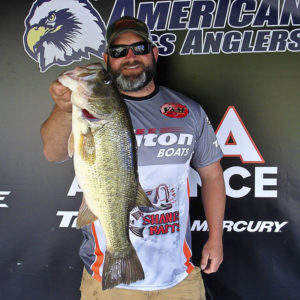
March is a big transition month for bass in waters across the Carolinas. Watch the weather and the water and load your livewell.
March is a big transition month for bass and bass anglers in the Carolinas.
Fish are heading to the shallows in prespawn mode, and depending on the weather, some will spawn before the end of the month. Some years, anglers will encounter prespawn, spawning, and even post-spawn bass this month.
That, plus the erratic weather that often occurs, can make bass fishing in March a challenge. It can also make it very rewarding. Some of the biggest bass of the year bite this month for a variety of reasons.
Brett Collins of Ridgeway, S.C., runs the Carolina Anglers Team Trail and the Carolinas Bass Classic tournament series. He is an also avid angler himself. March is one of his favorite months to fish, despite unpredictable weather.

“You really have to keep an eye on the weather this month. If you get a little warming trend for a few days in a row, the bass will be on fire,” he said. “It will push some of them to go ahead and spawn, or at least head to shallow water to prepare for it.”
Skip a jig
In March, Collins said bass on just about any lake will spend a lot of time under docks on the main lake. He targets these fish and prefers to do it with a jig. He dresses his jigs with soft-plastic trailers, then skips them under docks. Instead of making one long cast that hits the water only when it lands, he makes the lure skip like a stone. This gets the jig moving low enough to get under the docks and fast enough to get far under them.
“If you’re fishing on the outer fringes of the docks, or just a foot into them, you’re missing the best fish. The bigger fish hide way under there. You’ll catch some smaller ones on the outskirts, but it takes the right cast to pull the big ones out. They aren’t going to come after your jig this time of year, so you have to put it right where they are,” he said.
Collins said that no mater the weather, you’ll find some bass on main-lake docks throughout the month.

“Some of these are in prespawn mode,” he said. “They’re holding out, waiting for the right water temperature to go shallow and spawn. And some of them may have already spawned and are recovering before making their next move. The prespawn bass are a little tougher to catch. They are mainly concentrating on the water temperature and being where they need to be leading up to the spawn. But they will often bite if you put it right in their face. It’s an easy meal that they can’t resist.”
Bass use docks in all phases of the spawn
Post-spawn fish can be easier to catch, he said, because spawning is behind them, and they need energy.
“The post-spawn bass are pretty worn out. Their bodies have been through a lot. They’ll stop under the same docks to recover, rest and feed up. They can bite pretty aggressively and can make for some fun fishing,” he said.
Collins will work a dock thoroughly, but he said it’s no place to spend all day. A few good casts that put his jig deep under the dock or under pontoon boats parked at a dock, and he moves on to the next one. At some point, a good fish will bite.
The weather plays a big factor in March, and one of the biggest factors is rain, as well as snow from north of us melting and filling the rivers that eventually flood our lakes. That’s just what angler Michael Stephens of Charlotte, N.C., is looking for.
Stephens has won his share of bass tournaments, including the $50,000 Carolinas Bass Classic on Lake Wylie a few years ago in March. The water was high then — the kind of conditions in which he excels.
Don’t shy away when the water gets high
“These fish have it in their minds that they need to get shallow,” he said. “Some will stage at the mouths of creeks just waiting on the temperature to drop enough for them to make their move. They’ll be scattered out when conditions are normal, just waiting. But when the high water sets in, they get real predictable.”
Stephens said sudden flooding makes bass react similar to how humans react when the power goes out in their homes at nighttime.
“No matter where you’re standing when the power goes out and it gets dark, you’ve got a map in your head of the way your house is laid out. And the first thing most people do is feel for a wall or counter top to guide them. They want a reference point,” he said.
Find the reference points during high water
Likewise, when bass are waiting to head shallow to spawn, sudden flooding will push them to a reference point. They know they still have to head shallow soon. So they’ll find a reference point like a rock wall, a dock, or even the bank to hold close to while they wait on the weather to get just right.

“During high water, most people think the bass get real spread out, but the opposite is actually true. They’ll hold real tight to cover when the water gets high, just like a person will stay close to something familiar in the dark during a power outage,” he said.
Under those conditions, Stephens likes to cast crankbaits, double-bladed spinnerbaits, Chatterbaits, and 1/2-ounce jigs with trailers.
“Most people call it ‘junk fishing.’ I’ll cast tight to rock walls, main-lake docks, and banks — even the banks in deep water areas. On most days, one of those four lure types will work. Once I start getting bit, I’ll continue to target the same areas with whatever lure is working,” he said.
Watch the weather
When watching the weather this month, Brett Collins said he hopes for three things: stained water, a little wind and a few nights in the 50s.
“Even when you have some 60-plus degree days, it doesn’t usually help that much if it’s dropping into the 40s at night. You want three or more nights in a row in the 50s. The water is usually stained in March, which is good. And some wind always helps. It helps concentrate baitfish — and the bass chasing them. And it also covers mistakes anglers make. It will have fish chasing noisy lures rather than being startled by them,” he said.
Having a little wind also offers anglers some good targets at which to cast. Any type of structure that can break the wind, no matter how small, is a good spot to cast. Bass will hide behind it to ambush prey that gets pushed in by the wind. And they will readily bite a well-placed lure.
“The worst thing to see in March is a blue-sky, calm day.” Collins said. “I do want it to be relatively warm, but most of all, I want some wind, dirty water and high water. When fishing on days like that, find some reference points and start making casts. Eliminate the type of points they aren’t biting on. You’ll find out real quick what they’re biting, and you’ll catch your share.”




Be the first to comment